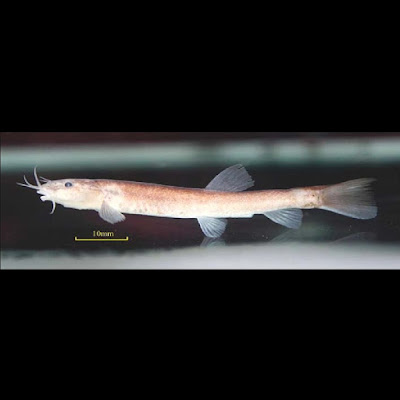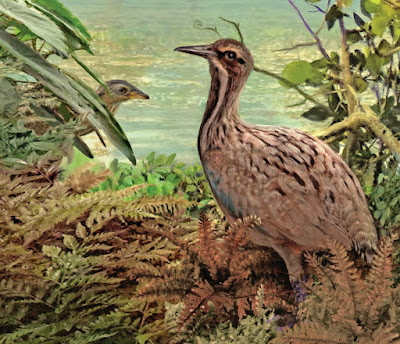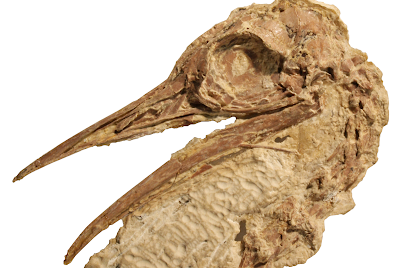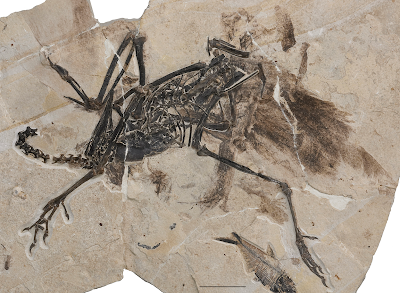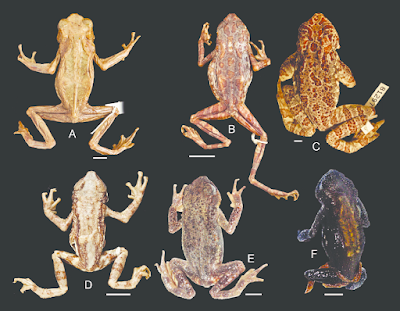[Most Recent Entries] [Calendar View]
Sunday, July 10th, 2016
| Time | Event | ||||||
| 1:20p | [Ichthyology • 2016] Oreonectes shuilongensis • A New Species of the Genus Oreonectes (Cypriniformes: Nemacheilidae) from Guizhou, China
Abstract This study examined the morphological and phylogenetic characteristics of Oreonectes shuilongensis sp. nov. The genus Oreonectes is distributed only in southwestern China and northern Vietnam. Sixteen specimens of cavefish were captured in the Shuilong Township in Guizhou Province of China and identified as a new species of Oreonectes (Cypriniformes: Nemacheilidae). Maximum likelihood was used to construct phylogenetic trees based on data for Nemacheilidae species accessible on GenBank. Molecular phylogenetic analyses showed that O. shuilongensis is closely related to O. platycephalus from which it is distinguished by having 6 vs. 5 branched anal rays, ratio of body length to body height 7.0–7.9 vs. 5.6–7.0, ratio of head length to distance between eyes 3.5–4.9 vs. 2.0–2.4, naked vs. scaly body, densely distributed fine black stains except on abdomen, and semitransparent body. Oreonectes shuilongensis is the only species of the genus not distributed in Guangxi Province. This study has contributed to the overall knowledge about the distribution of Oreonectes. Keywords: Pisces, Nemacheilidae, Oreonectes, new species, cave fishes, Guizhou Habitat. The species inhabits an underground river flowing in a cave. The cave, which opens near a hilltop, is approximately 150–200 m in length. The underground river is near the bottom of the cave and is approximately 15m long and 0.15–0.85 m wide. Its flow is gentle and clear, and the average depth of the water is 0.40 m. This new species was observed at depths of 0.01–0.40 m. In the underground river, the only other aquatic organisms found were small shrimps. Etymology. The specific epithet is based on the Chinese name “Shuilong,” which is the name of the township where the specimens were collected. Discussion: Sequences for cytb were analyzed for several genera and species of nemacheilids using Mage 5.05 to elucidate relationships. The result showed Oreonectes to be genetically distant from all other genera (Fig. 4). The genetic distance between O. shuilongensis and O. platycephalus was 0.789, and the difference in the cytb sequences between O. shuilongensis and O. platycephalus was 15%, which was much higher than the genetic distance between several species (0.02–0.16) of Schistura. The results are consistent with the morphological data supporting O. shuilongensis as a separate species. The genus Oreonectes is distributed in subterranean rivers in the karst land of the southwestern region of China. Oreonectes platycephalus is distributed across a wide area, mainly in Hong Kong, Guangdong, which belongs to the Pearl River system; and Guangxi, northern Vietnam, which belongs to the Red River system. The other 15 species are all distributed in the karst areas of Guangxi. O. shuilongensisis is distributed only in Guizhou Province and is the first species of the genus Oreonectes not distributed in Guangxi. The present findings contribute to the overall knowledge about the distribution of Oreonectes. H. Deng, N. Xiao, X. Hou and J. Zhou. 2016. A New Species of the Genus Oreonectes (Cypriniformes: Nemacheilidae) from Guizhou, China. Zootaxa. 4132(1); 143–150. DOI: 10.11646/zootaxa.4132.1.13 | ||||||
| 1:25p | [PaleoOrnithology • 2016] Calciavis grandei • The Anatomy and Taxonomy of the Exquisitely preserved Green River Formation (early Eocene) Lithornithids (Aves) and the Relationships of Lithornithidae
Abstract Fossil remains of Paleogene Palaeognathae are poorly documented and are exceedingly rare. One group of palaeognaths, the lithornithids, is well represented in the Paleogene of North America. Nevertheless, few specimens of the same species are known from each of those Paleogene geologic units. Here, we report five new partial skeletons of lithornithids from the Fossil Butte Member of the Green River Formation (early Eocene) of Wyoming. One spectacularly preserved specimen is identified as the holotype of a new species, Calciavis grandei, gen. et sp. nov., and fully described. Preserved soft tissues (e.g., feathers, pes scales) surround the nearly articulated and complete skeleton. A second well-preserved but disarticulated skeleton is referred to this new taxon. We conclude that there are only two lithornithid taxa in the Green River Formation after careful comparisons with the other known taxon from the same geological unit, Pseudocrypturus cercanaxius. Morphological data generated from the new taxon and other Green River Formation lithornithid specimens were integrated into a osteology-only phylogenetic data set containing stem avians as outgroups and extinct and extant members of Palaeognathae (Tinamidae, ratites) and Neognathaes (Anseriformes, Galliformes, Neoaves), unnamed lithornithid specimens, and the following named lithornithid taxa: Lithornis plebius, Lithornis promiscuus, Lithornis celetius, Paracathartes howardae. We find a monophyletic Lithornithidae (containing Calciavis grandei, Pseudocrypturus cercanaxius, Lithornis plebius, Lithornis promiscuus, Lithornis celetius, Paracathartes howardae) as the sister taxon of Tinamidae at the base of Palaeognathae and also recover a monophyletic Ratitae in the morphology-only analysis. A Lithornithidae-Tinamidae relationship, which could imply a broad Northern Hemisphere distribution in the Paleogene for this total group retracted to the present day Neotropical distribution after the Eocene, is weakly supported in our analysis and is also supported by other lines of evidence such as eggshell morphology. Relationships among flightless palaeognaths and assessment of character homology in this group remain problematic. Indeed, when the morphological analyses were constrained to enforce topologies recovered from all recent analyses of molecular sequence data and retroelement insertions, Lithornithidae is no longer recovered with Tinamidae, which is nested within the now paraphyletic ratites, but remains at the base of Palaeognathae. Thus, regardless of the position of Tinamidae, Lithornithidae is recovered at the base of the clade. However, evidence that many, if not all, of these "ratite" lineages independently evolved similar morphologies related to large size and flight loss suggests that the proposed position of the Lithornithidae remains tentative. Significant morphological variation within Lithornithidae should be captured in inclusive future analyses through use of species terminals.
Nesbitt, Sterling J. and Clarke, Julia A. 2016. The Anatomy and Taxonomy of the Exquisitely preserved Green River Formation (early Eocene) Lithornithids (Aves) and the Relationships of Lithornithidae. Bulletin of the American Museum of Natural History. 406. URI: http://hdl.handle.net/2246/6664 Supplemental Material: 10.5531/sd.sp.25 Well-preserved fossils show ostrich relatives lived in North America 50 million years ago http://vtnews.vt.edu/articles/2016/07/sc | ||||||
| 1:32p | [Herpetology • 2015] Taxonomic Reassessment of the Arboreal Toad Genus Pedostibes Günther 1876 (Anura: Bufonidae) and Some Allied Oriental Bufonid Genera
Abstract We reassessed the taxonomic status of an Asian genus of arboreal bufonids, Pedostibes, based on examination of preserved material of the two species currently attributed to this genus. Analysis of their morphological, morphometric, and geographic distribution data revealed that Pedostibes tuberculosus, the type species of this genus from the Western Ghats, southwestern India, is morphologically distinct from the geographically separated member, P. kempi, which is distributed in northeastern India. Hence, the generic nomen Pedostibes is restricted to the type species, rendering it a monotypic genus from the Western Ghats of peninsular India. A re-examination and detailed comparisons of the types of P. kempi with other bufonid genera revealed morphological similarities with another geographically proximate toad, Bufoides meghalayanus, from northeastern India. Hence, this taxon is formally transferred herein to Bufoides with a redescription. The composition of the recently described Southeast Asian toad genus Rentapia is reevaluated and the name-bearing type specimens of the currently ascribed taxa are redescribed. A detailed examination of the types of Rentapia everetti and R. rugosa revealed morphological congruence coupled with geographic sympatry. Hence, the latter nomen is synonymized with R. everetti in accordance with the International Code of Zoological Nomenclature principle of priority. Keywords: Arboreal anuran, Morphometric analyses, Northeastern India, Western Ghats S.R. Chandramouli and A.A. Thasun Amarasinghe. 2016. Taxonomic Reassessment of the Arboreal Toad Genus Pedostibes Günther 1876 (Anura: Bufonidae) and Some Allied Oriental Bufonid Genera. Herpetologica. 72(2): 137-147. DOI 10.1655/HERPETOLOGICA-D-15-00053 | ||||||
| 3:38p | [Herpetology • 2012] Coryphophylax brevicaudus • A New Species of Coryphophylax Fitzinger in: Steindachner, 1867 (Iguania: Agamidae) from the Andaman Islands, India ABSTRACT The systematic position of the agamid genus Coryphophylax (Squamata: Agamidae) is given as monotypic and endemic to the Andaman and Nicobar Islands in the Bay of Bengal, India. After having surveyed intensively in thirteen different Islands and examined several individuals in the Andamans group of islands, we describe a second species of Coryphophylax from the lowland rainforests of the South Andaman Island. Coryphophylax brevicaudus sp. nov. is differentiated from its congener, C. subcristatus (Blyth, "1860" 1861) by its smaller size, relatively shorter tail, presence of nuchal and dorsal crests in both sexes, midbody scale row counts and colour pattern. The new species lives in sympatry with C. subcristatus. The taxonomic history and systematic status of the genus Coryphophylax are discussed, and the need for continued surveys in the Islands is emphasized. Key words: Squamata, Iguania, Agamidae, Coryphophylax brevicaudus sp. nov., Andaman Islands, India Harikrishnan S., Karthikeyan Vasudevan, S.R. Chandramouli, B.C. Choudhary, Sushil Kumar Dutta and Indraneil Das. 2012. A New Species of Coryphophylax Fitzinger in: Steindachner, 1867 (Sauria: Iguania: Agamidae) from the Andaman Islands, India. Zootaxa. 3451:31-45. |
| << Previous Day |
2016/07/10 [Calendar] |
Next Day >> |
